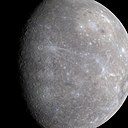File:Mercury in color - Prockter07-edit1.jpg
Appearance

Hammi agarsiisa yaalii: pikseelii 600 × 600. Kabiraa furmaatawwan: pikseelii 240 × 240 | pikseelii 480 × 480 | pikseelii 768 × 768 | pikseelii 1,024 × 1,024 | pikseelii 1,950 × 1,950.
Faayila abbaa (1,950 × 1,950 pixels, file size: 734 KB, MIME type: image/jpeg)
Seenaa faayilaa
Faayilicha sa'aa san akka itti mul'atetti ilaaluuf guyyaa/yeroo cuqaasi.
| Guyyaa/Sa'aa | Qeensa abgudduu | Kallattiiwwan | Fayyadamaa | Yaada | |
|---|---|---|---|---|---|
| amma | 15:12, 3 Waaxabajjii 2008 |  | 1,950 × 1,950 (734 KB) | Jjron | {{Information |Description={{Information |Description=Full color image of from first MESSENGER flyby |Source=NASA/JPL [http://messenger.jhuapl.edu/gallery/sciencePhotos/image.php?page=1&gallery_id=2&image_id=143] |Date=2008-01-30 |Author=NASA/[ |
Fayyadamiinsa faayilaa
Kutaan itti anuu "file"ii kanan walitti qabatta:
Fayyadamiinsa faayila guutu addunyaa
Wikileen biroo kan armaan gadi jiran fayila kana fayyadamu:
- Fayyadamiinsa ar.wikipedia.org irratti
- المجموعة الشمسية
- عطارد
- كوكب
- بوابة:المجموعة الشمسية/مقالة متميزة
- ويكيبيديا:صور مختارة/الفضاء والكون/نظرة إلى الأعلى
- بوابة:علم الفلك/صورة مختارة
- ويكيبيديا:ترشيحات الصور المختارة/عطارد بالألوان
- ويكيبيديا:صورة اليوم المختارة/يناير 2018
- قالب:صورة اليوم المختارة/2018-01-13
- بوابة:علم الفلك/صورة مختارة/52
- بوابة:المجموعة الشمسية/مقالة متميزة/3
- ويكيبيديا:صورة اليوم المختارة/أغسطس 2021
- بوابة:كواكب
- بوابة:كواكب/كوكب مختار
- قالب:صورة اليوم المختارة/2021-08-24
- بوابة:كواكب/كوكب مختار/2
- قالب:صورة اليوم المختارة/2024-10-30
- Fayyadamiinsa ary.wikipedia.org irratti
- Fayyadamiinsa arz.wikipedia.org irratti
- Fayyadamiinsa ast.wikipedia.org irratti
- Fayyadamiinsa as.wikipedia.org irratti
- Fayyadamiinsa ay.wiktionary.org irratti
- Fayyadamiinsa azb.wikipedia.org irratti
- Fayyadamiinsa az.wikipedia.org irratti
- Merkuri (planet)
- Planet
- Vikipediya:Həftənin seçilmiş məqaləsi/oktyabr 2016
- Vikipediya:Həftənin seçilmiş məqaləsi/42. Həftə 2016
- Portal:Günəş sistemi/Seçilmiş məqalə
- Portal:Günəş sistemi
- Vikipediya:Həftənin seçilmiş məqaləsi/sentyabr 2017
- Vikipediya:Həftənin seçilmiş məqaləsi/36. Həftə 2017
- Vikipediya:Həftənin seçilmiş məqaləsi/yanvar 2018
- Vikipediya:Həftənin seçilmiş məqaləsi/5. Həftə 2018
- Fayyadamiinsa ba.wikipedia.org irratti
- Fayyadamiinsa bcl.wikipedia.org irratti
- Fayyadamiinsa be.wikipedia.org irratti
- Fayyadamiinsa bew.wikipedia.org irratti
- Fayyadamiinsa bh.wikipedia.org irratti
- Fayyadamiinsa bn.wikipedia.org irratti
- Fayyadamiinsa btm.wikipedia.org irratti
- Fayyadamiinsa ca.wikipedia.org irratti
Mul'isa fayyadama duniyaalessa edaasaa harshama kanaa.




